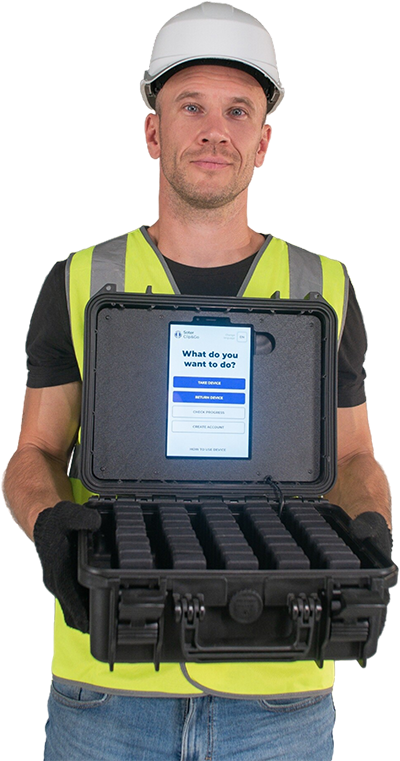How To Boost Employee Engagement With Wearable Safety Tech
You probably already know that people are your company’s greatest asset. A belief widely shared by successful business leaders across the globe; from Richard Branson to Stephen Covey. It is simply not possible to build a prosperous business without good people.
But the real question is, once we’ve found them how do we keep good people? Each new hire costs upwards of $4,000 USD on average. Once you’ve invested in hiring the right person, how do you build them up and get the best performance out of them?

You probably already know that people are your company’s greatest asset. A belief widely shared by successful business leaders across the globe; from Richard Branson to Stephen Covey. It is simply not possible to build a prosperous business without good people.
But the real question is, once we’ve found them how do we keep good people? Each new hire costs upwards of $4,000 USD on average. Once you’ve invested in hiring the right person, how do you build them up and get the best performance out of them?
The solution is engagement. Successful businesses implement strategies that actively build and encourage employee engagement. Fostering a strong mental and emotional connection between workers and their job, team and organization to maximize performance and minimize turnover.
Unfortunately, deeply engaged employees are rare. Research shows that only about 15% of workers worldwide are engaged with their work. As many as 13% are actively disengaged and a further 51% are mentally disconnected from their jobs and the companies they work for.
From Engagement To Prosperity
A truly engaged team leads to higher productivity, lower turnover, better service quality, lower rates of absenteeism, improved employee health and a reduction in workplace injuries.
Higher levels of engagement have been proven to reduce turnover by 43%. This positive impact on staff retention has a ripple effect of benefits across the organization. Highly engaged teams are also likely to be more productive with research showing that productivity increases by 17%. All of these positive impacts of high engagement also leads reduced rates of employee absences. Research has found that high levels of engagement lowers absenteeism by 41%.
The ripple effects of high engagement expands further to a direct positive impact on safety in the workplace. Workers who are actively engaged are 2.5 times more likely to report injuries and safety incidents. They are also 5 times less likely to have a safety incident to begin with. If they do happen to have a safety incident at work, they are 7 times likely to lose any work time.
Not only do engaged workplaces have 70% fewer safety incidents but highly engaged teams lead to a 23% increase in profitability.
Looking at all of the ripple effects of higher engagement, it is clear to see the importance of fostering engagement in your own organization. But how? Let’s take a look at the underlying drivers.
The 5 Key Drivers of Engagement
Engagement is directly linked to the way in which employees are managed. Good management builds and keeps good people. Researchers have identified key things that actively trigger disengagement. This includes a lack of feedback and recognition, limited investment in resources and technology, a company culture that does not value employee wellbeing and managers who lack empathy.
So how can we avoid these mistakes and actively grow engagement? Let’s look at the five key drivers of employee engagement.
A Clear Purpose
Engagement starts with culture. Leadership from the top down modeling positive culture, building a clear purpose and direction for everyone that motivates dedication. We all want to be a part of something bigger than ourselves and a company that provides each employee with a clear purpose engages that innate human sense.
Development Opportunities
People also want development; the opportunity to grow personally and professionally. Companies that invest in training and provide clear pathways for growth, engage workers in their own development, strengthening the bond between them, their job and their organization.
Caring & Empathetic Managers
No one wants to work for a company that doesn’t care about them. Workers who feel that they are valued become the champions of engagement. Caring management is built upon flexibility, autonomy and empathy. Managers who understand and adapt to the unique situations of each worker, encourage and trust them to take ownership and responsibility for their work and who act with genuine care and empathy inspire loyalty and, as a consequence, engagement.
Regular Ongoing Conversations
Deliberate and regular two-way conversations with employees facilitates empowered communication. Giving workers a voice and actively listening engages them in their role. This ongoing conversation makes them feel trusted to provide input; knowing that their contribution matters.
A Focus on Strengths
Everyone wants to feel like they are positively contributing to the work that they do through their strengths. Research shows that workers with managers that focus on their strengths are much less likely to be disengaged. A focus on weaknesses or, even worse, being ignored is much more likely to create disengagement. Thus, regularly praising and talking to employees about their strengths fosters stronger engagement.
The Role of Safety Technology in Engagement
One great, simple strategy for building engagement is to invest in technology that delivers on each of the five key drivers of engagement such as safety wearables.
AI-driven wearable technology is shaking things up seeing organizations around the world weaving wearables into their processes. Solutions to assist workers to learn more about their movements, understand them, and help reduce their risk of injury – permanently.
Small lightweight wearable devices designed to monitor the behavior of workers and alert of any hazardous movements that could lead to back or shoulder injuries. These alerts improve awareness and reduce the overall risk of injury. Track progress, complete training modules, analyze data and produce visually appealing reports through mobile apps and centralized dashboards to target and reduce ergonomic risk.
Not only does this technology teach workers to move better, improve safety and reduce injuries but it also ticks all the boxes for building better engagement across the board.
Safety wearables give workers purpose and direction as they focus on clear, achievable safety goals. Actively encouraging improvement, safety wearables are an investment in development that shows a company commitment to workers and their growth.
It also provides an opportunity for management to show that they genuinely care about the wellbeing of their workers. Safety wearables are designed with the worker in mind; a tailored experience unique to each worker that empowers them to have informed conversations with their managers. Workers are engaged in the process with autonomy to follow and track their own progress, compare results with co-workers, complete in-app manual handling training tutorials at their own time and pace (increasing learning retention) and make sustainable changes to their behavior.
AI-driven wearable safety technology also facilitates the chance to highlight and praise the strengths and achievements of every employee. With reliable metrics that show progress, it is easy to focus on improvement and move away from talking about weaknesses. Some platforms even integrate gamification into their wearables, making the whole process fun, collaborative and constructive.
How To Track & Measure Engagement
After reading all about the benefits of engagement, the key drivers and the impact of safety wearable technology on engagement, you might be wondering how you would even know the engagement levels in your organization and how you can measure and track it? Fear not, many other organizations have been through this before and there are tried and tested measures.
If you are serious about incorporating engagement initiatives into your daily mission to ensure you attract and keep the best talent, then it is vital that you understand the current state of engagement first. One easy way to gauge this is through an engagement survey. Your survey should be carefully curated to ascertain your workforce’s motivation, and to gain insight into their thoughts and attitudes towards their work and the overall working environment.
Your initial engagement survey will provide you with a baseline from which to start actively planning to generate better engagement. From here you can invest in new technologies and implement new activities throughout your organization. If you’re doing it right, subsequent engagement surveys will show the results. It is paramount to keep your finger on the pulse when it comes to engagement, conducting regular surveys to measure and track will facilitate success.
How Soter Analytics Can Help
Soter Analytics is one of the few large players in the ergonomic tech game for material handling. The wearable safety solutions developed by Soter Analytics are currently being successfully implemented by a number of leading organizations globally including Kenco Logistics (US), BSS Industrial (UK), Giant Eagle (US) and Coca Cola Amatil to reduce workplace injuries.
All highly advanced technology companies provide similar products that measure movement and give valuable insight to the wearer via feedback and through the collected data for the organization. But Soter’s technology is so much more than just injury prevention. Soter Analytics prides itself on creating a user-friendly and engaging experience for workers that makes work and safety fun.
Soter Analytics identified the need to create a cultural shift in how workers connect with safety training and invested in an application that makes their wearables fun; gamification. Based on the videogame elements of competition, reward, challenge and social engagement, Soter has focused on improving the efficacy of engagement efforts without increasing costs.
Dr. Anastasia Vasina, Chief Product Officer at Soter Analytics leading the gamification project says, “Why can’t safety be fun? Why is there a stigma around safety being boring and an obligation rather than a continuing game of getting it right? Aligning the value of safety to excitement and using games to motivate, educate and empower a worker’s commitment to safety, is what we are focusing on to drive down injury rates and encourage safe movement”.
Soter Analytics provides technology solutions to prevent and reduce workplace ergonomic injuries but it is so much more than that. At its core, Soter Analytics is about providing engaging solutions that can motivate your employees to take ownership of their own safety, connect them with their bodies and empower them to have meaningful conversations about their safety.
About Soter Analytics
Soter Analytics is a global safety science company producing AI-supported wearable solutions that reduce the risk of ergonomic injuries in the workplace. Soter wearables are widely used in logistics, manufacturing, healthcare and other industries, helping leading companies to prevent up to 55% of back & shoulder musculoskeletal injuries.
To see how Soter Analytics can help you improve safety behavior, engage employees to self-manage their training and prevent workplace ergonomic injuries, simply Book a FREE Demo today.


